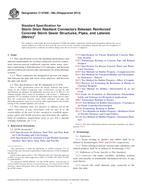Potřebujeme váš souhlas k využití jednotlivých dat, aby se vám mimo jiné mohly ukazovat informace týkající se vašich zájmů. Souhlas udělíte kliknutím na tlačítko „OK“.
ASTM D5886-95(2011)
Standard Guide for Selection of Test Methods to Determine Rate of Fluid Permeation Through Geomembranes for Specific Applications
Automaticky přeložený název:
Standardní Příručka pro výběr zkušebních metod, určit míra Fluid průnik geomembranes pro specifické aplikace
NORMA vydána dne 1.6.2011
Informace o normě:
Označení normy: ASTM D5886-95(2011)
Poznámka: NEPLATNÁ
Datum vydání normy: 1.6.2011
Kód zboží: NS-32949
Počet stran: 8
Přibližná hmotnost: 24 g (0.05 liber)
Země: Americká technická norma
Kategorie: Technické normy ASTM
Kategorie - podobné normy:
Anotace textu normy ASTM D5886-95(2011) :
Keywords:
barriers, diffusion of gases and vapors, flexible membrane liners (FMLs), gas transmission, leachate, organic vapor transmission, permeability, polymeric geomembranes, reservoirs, transport of chemical species, transport of ions, waste disposal, water vapor transmission, Barrier materials/systems, Diffusion (gases/vapors), Flexible membrane liners (FMLs), Ion transport, Leachates/leaching, Organic vapor transmission, Permeability--geosynthetics, Polymeric geomembranes, Reservoirs
Doplňující informace
| Significance and Use | ||||||||||||||||||
|
The principal characteristic of geomembranes is their intrinsically low permeability to a broad range of gases, vapors, and liquids, both as single-component fluids and as complex mixtures of many constituents. As low permeable materials, geomembranes are being used in a wide range of engineering applications in geotechnical, environmental, and transportation areas as barriers to control the migration of mobile fluids and their constituents. The range of potential permeants is broad and the service conditions can differ greatly. This guide shows users test methods available for determining the permeability of geomembranes to various permeants. The transmission of various species through a geomembrane is subject to many factors that must be assessed in order to be able to predict its effectiveness for a specific service. Permeability measurements are affected by test conditions, and measurements made by one method cannot be translated from one application to another. A wide variety of permeability tests have been devised to measure the permeability of polymeric materials; however, only a limited number of these procedures have been applied to geomembranes. Test conditions and procedures should be selected to reflect actual service requirements as closely as possible. It should be noted that field conditions may be difficult to model or maintain in the laboratory. This may impact apparent performance of geomembrane samples. This guide discusses the mechanism of permeation of mobile chemical species through geomembranes and the permeability tests that are relevant to various types of applications and permeating species. Specific tests for the permeability of geomembranes to both single-component fluids and multicomponent fluids that contain a variety of permeants are described and discussed. |
||||||||||||||||||
| 1. Scope | ||||||||||||||||||
|
1.1 This guide covers selecting one or more appropriate test methods to assess the permeability of all candidate geomembranes for a proposed specific application to various permeants. The widely different uses of geomembranes as barriers to the transport and migration of different gases, vapors, and liquids under different service conditions require determinations of permeability by test methods that relate to and simulate the service. Geomembranes are nonporous homogeneous materials that are permeable in varying degrees to gases, vapors, and liquids on a molecular scale in a three-step process (1) by dissolution in or absorption by the geomembrane on the upstream side, (2) diffusion through the geomembrane, and (3) desorption on the downstream side of the barrier. 1.2 The rate of transmission of a given chemical species, whether as a single permeant or in mixtures, is driven by its chemical potential or in practical terms by its concentration gradient across the geomembrane. Various methods to assess the permeability of geomembranes to single component permeants, such as individual gases, vapors, and liquids are referenced and briefly described. 1.3 Various test methods for the measurement of permeation and transmission through geomembranes of individual species in complex mixtures such as waste liquids are discussed. 1.4 This standard does not purport to address all of the safety concerns, if any, associated with its use. It is the responsibility of the user of this standard to establish appropriate safety and health practices and determine the applicability of regulatory limitations prior to use. |
||||||||||||||||||
| 2. Referenced Documents | ||||||||||||||||||
|
Podobné normy:
Historická
1.7.2013
Historická
15.9.2011
Historická
15.6.2012
Historická
1.9.2012
Historická
1.9.2011
Historická
1.4.2013
Doporučujeme:
Aktualizace zákonů
Chcete mít jistotu o platnosti užívaných předpisů?
Nabízíme Vám řešení, abyste mohli používat stále platné (aktuální) legislativní předpisy.
Chcete vědět více informací? Podívejte se na tuto stránku.



 ASTM C1478M-08a(2013..
ASTM C1478M-08a(2013.. ASTM C1745/C1745M-11..
ASTM C1745/C1745M-11.. ASTM C1746/C1746M-12..
ASTM C1746/C1746M-12.. ASTM C443-12
ASTM C443-12 ASTM C443M-11
ASTM C443M-11 ASTM C478-13
ASTM C478-13
 Cookies
Cookies
